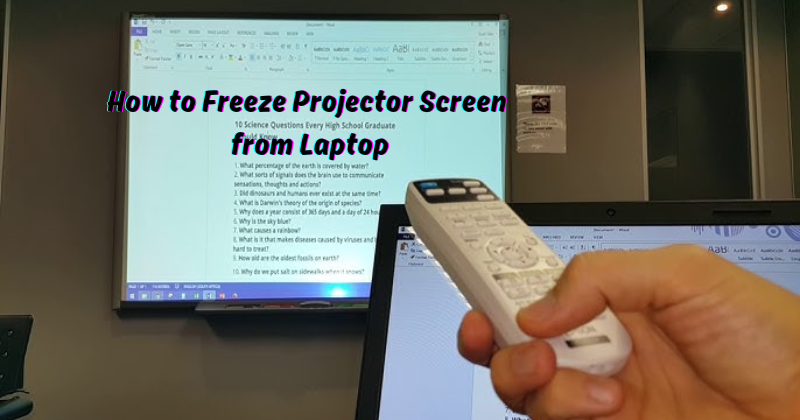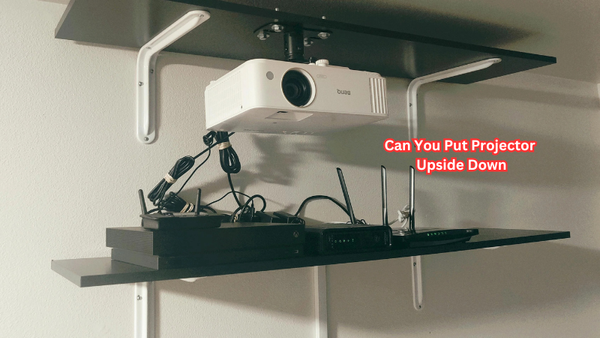Freezing a projector screen from a laptop can be a convenient and efficient way to capture and hold a particular image or presentation.
Whether you're giving a presentation, conducting a training session, or wanting to pause an important visual, knowing how to freeze the projector screen can be useful.
You can temporarily freeze the projected image without interrupting the rest of your laptop's functionality by utilizing the right keyboard shortcuts or software options. This allows you to focus on specific details, take a break, or engage with your audience without worrying about the projection changing.
This guide will explore different methods to freeze a projector screen from your laptop, ensuring a smooth and uninterrupted presentation experience.
Why Do You Need to Freeze Your Projector Screen?
Freezing your projector screen serves several essential purposes. Firstly, it allows presenters to maintain a static image on the screen, enabling extended discussions or in-depth analysis of a specific point without distractions from changing visuals.
This feature is precious when emphasizing critical information, intricate details, or data points. Moreover, freezing the projector screen enhances audience engagement by providing them with a steady reference point, fostering better comprehension.
It also facilitates interactive sessions, enabling presenters to answer questions or address comments without the visuals constantly shifting. During movie-watching sessions, freezing the projector screen can be useful for pausing and discussing specific scenes or moments.
Ultimately, freezing the projector screen is a valuable tool for effective communication, ensuring that information is conveyed smoothly and comprehensively.
How to Freeze Projector Screen from Laptop?
Before we dive into the specific methods, it's important to note that different laptops may have different keyboard shortcuts and software options. Check your laptop's user manual or online resources for accurate and up-to-date instructions.
For Windows Users:
If you have a Windows laptop and you want to freeze screen of the projector, here's how you can do it: Windows laptops have a unique feature called Extended Mode.
Commencing with Windows' Extended mode, let's delve into this configuration. Originally, you would be required to link your projector screen or second display.
- To begin with, connect your laptop to the projector screen using a VGA or HDMI cable.
- Once connected, press and hold the Windows key and hit the P button simultaneously.
- A sidebar will appear on the right side of your screen; click on "Extend" mode.
- Your laptop screen will now be duplicated onto the projector screen.
- To freeze the display on the projector screen, simply press and hold the Windows key and hit the F7 button simultaneously.
- This will freeze the image on your laptop and projector screens until you press any other key or click your mouse again.
Like this, you can easily freeze your projector screen from a laptop using the Extended Mode feature.
If your laptop doesn't have the Extend mode feature, you can also use the Duplicate mode to freeze the projector screen. Simply follow steps 1-4, press and hold the Windows key, and hit the F7 button simultaneously. This will also freeze the display on your laptop and projector screens in duplicate mode.
Expand Desktop mode on your Windows 10 laptop is another option for freezing your projector screen. You can follow the same steps as in Extend Mode and then press and hold the Windows key while hitting the F5 button to freeze the display.
For Mac Users:
Mac laptops have a similar feature to freeze the projector screen but with different keyboard shortcuts. Follow these steps to utilize it:
- Connect your Mac laptop to the projector screen using a VGA or HDMI cable.
- Once connected, press and hold the Command key and hit the F7 button simultaneously.
- This will immediately freeze the display on both your laptop and projector screens.
- To unfreeze the screen, simply repeat the same keyboard shortcut or click your mouse.
These are the steps to freeze your projector screen from a Mac laptop. For PC screen, the process is relatively similar as well. It's handy having the freeze screen option on your projector image.
Another way mirror mode allows for freezing the projector screen for Mac users. After connecting your laptop to the projector screen, simply press and hold the Command key and hit the F5 button simultaneously.
This will duplicate your display onto both screens and freeze it until you click your mouse again or use the keyboard shortcut to turn off mirroring.
Using Software Options
If you cannot use keyboard shortcuts or prefer a different method, you can utilize software options to freeze your projector screen. This may involve using the built-in software on your laptop or downloading third-party applications.
Using Built-in Software:
- Microsoft PowerPoint: If you are presenting through Microsoft PowerPoint, you can utilize the "Presenter View" option to freeze the screen. Click on "Slide Show" and then select "Presenter View." This will allow you to control what is shown on the projected screen while keeping your laptop screen frozen.
- Mac Preview: The Preview application allows Mac users to freeze and unfreeze the projected screen. Open the Preview application, select "View" and click "Slideshow." From there, you can control the screen by clicking on the appropriate options in the toolbar.
Using Third-Party Applications:
If you use a different software or prefer more functionality, you can also download third-party applications that freeze and unfreeze your projector screen. Some popular screen freeze option include Screen Freeze, Freeze Frame, and Split Screen.
Troubleshooting Common Issues When Freezing Your Projector Screen from Laptop
While the above methods should work smoothly, here are some common troubleshooting tips in case you encounter any issues when trying to freeze your projector screen:
- If the projected image is not freezing, you're using a different keyboard shortcut. Check your laptop's user manual or online resources for the correct combination.
- If the projected image freezes but then unfreezes automatically, ensure you're not accidentally pressing any keys or clicking your mouse while trying to freeze the screen.
- If you ca unable freeze the projector screen, try restarting your laptop and reconnecting it to the projector screen. If the issue persists, check for any updates or contact technical support.
Alternative Methods for Freezing Your Projector Screen
In addition to the methods previously mentioned, there are alternative options for freezing your projector screen from a laptop. One approach involves leveraging presentation software like Google Slides or Prezi, which offer features similar to freezing the screen. Another method is to use an HDMI splitter to connect your laptop and projector screen, then utilize the projector's remote control to freeze the display. Projector remote so handy in screen freeze situation.
Alternatively, you can adjust your laptop's display settings to duplicate or extend the screen and use keyboard shortcuts to freeze the display. Additionally, employing a wireless presentation clicker with a dedicated freeze button provides a convenient option. The choice of method depends on personal preference and available resources. Regardless of the approach, the ability to freeze the projector screen proves invaluable for engaging with your audience and delivering a seamless presentation.
Tips and Tricks for Maximizing Your Frozen Projector Screen Experience
- Practice using the freeze feature before your presentation to ensure you are comfortable with the process and know which method works best for you.
- Utilize presenter view or another software option if you need to refer back to specific slides while keeping your projector screen frozen.
- Adjust the display settings on your laptop to fit the projector's screen size, as this can affect the quality of the frozen image.
- If you are using an external audio source, mute it while your screen is frozen to avoid interruptions or distractions.
- Remember to unfreeze the screen once you are done presenting, as not doing so may cause issues when trying to use your laptop again.
Following these tips and tricks, you can effectively utilize the freeze feature and confidently deliver your presentation with a frozen projector screen. So, next time you're presenting, don't be afraid to use the freeze feature to engage and interact with your audience.
FAQs
Can you freeze a projector screen?
Yes, you can freeze a projector screen. The steps may vary depending on your laptop and operating system, but several methods are available to achieve this. You may need to use additional software or hardware options for multiple monitors. External monitor and projector freezing allows you to control what is displayed on the projected screen while keeping your laptop's screen frozen.
What is the shortcut for freezing the screen?
For Mac users, the shortcut is Command + F7. For Windows users, it may differ depending on your laptop and operating system. You may need to check their user manuals or online resources for the appropriate shortcut for software or third-party applications.
Can you touch a projector screen?
It is generally not recommended to touch a projector screen, as it can affect the image quality and potentially damage the screen. Plus, with the freezer feature, there is no need to touch the screen during a presentation. However, if you need to make adjustments or interact with the projected image, use clean and dry hands.
Is the projector screen a real image?
It depends on the type of projector and screen being used. Some projectors use mirrors to reflect an image, while others use lenses to project a real image onto the screen. Regardless, the freeze feature ensures that the projected image stays still and clear for your audience.
Conclusion
In conclusion, freeing a projector screen from your laptop can greatly enhance your presentation and communication skills. By mastering the art of freezing the projected image, you gain more control over your visuals and can effectively engage with your audience. Freezing the projector screen offers flexibility and convenience, whether you want to analyze a specific detail, allow for discussion, or simply take a break.
Utilizing keyboard shortcuts or software options, you can seamlessly pause the projection without affecting the rest of your laptop's functionality. This allows you to maintain a smooth flow during your presentation and ensures that your audience remains focused on the desired content. With practice and familiarity, freezing the projector screen becomes second nature, empowering you to deliver impactful and memorable presentations.
So, embrace this skill, harness its potential, and take your presentations to new heights of professionalism and effectiveness.





